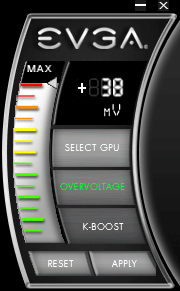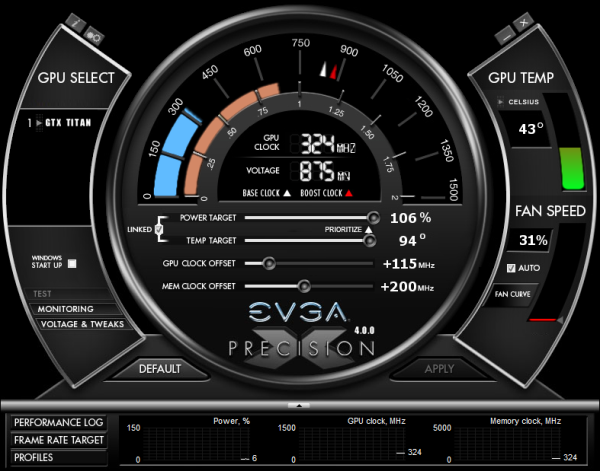NVIDIA’s GeForce GTX Titan Review, Part 2: Titan's Performance Unveiled
by Ryan Smith & Rahul Garg on February 21, 2013 9:00 AM ESTThe Final Word On Overclocking
Before we jump into our performance breakdown, I wanted to take a few minutes to write a bit of a feature follow-up to our overclocking coverage from Tuesday. Since we couldn’t reveal performance numbers at the time – and quite honestly we hadn’t even finished evaluating Titan – we couldn’t give you the complete story on Titan. So some clarification is in order.
On Tuesday we discussed how Titan reintroduces overvolting for NVIDIA products, but now with additional details from NVIDIA along with our own performance data we have the complete picture, and overclockers will want to pay close attention. NVIDIA may be reintroducing overvolting, but it may not be quite what many of us were first thinking.
First and foremost, Titan still has a hard TDP limit, just like GTX 680 cards. Titan cannot and will not cross this limit, as it’s built into the firmware of the card and essentially enforced by NVIDIA through their agreements with their partners. This TDP limit is 106% of Titan’s base TDP of 250W, or 265W. No matter what you throw at Titan or how you cool it, it will not let itself pull more than 265W sustained.
Compared to the GTX 680 this is both good news and bad news. The good news is that with NVIDIA having done away with the pesky concept of target power versus TDP, the entire process is much simpler; the power target will tell you exactly what the card will pull up to on a percentage basis, with no need to know about their separate power targets or their importance. Furthermore with the ability to focus just on just TDP, NVIDIA didn’t set their power limits on Titan nearly as conservatively as they did on GTX 680.
The bad news is that while GTX 680 shipped with a max power target of 132%, Titan is again only 106%. Once you do hit that TDP limit you only have 6% (15W) more to go, and that’s it. Titan essentially has more headroom out of the box, but it will have less headroom for making adjustments. So hardcore overclockers dreaming of slamming 400W through Titan will come away disappointed, though it goes without saying that Titan’s power delivery system was never designed for that in the first place. All indications are that NVIDIA built Titan’s power delivery system for around 265W, and that’s exactly what buyers will get.
Second, let’s talk about overvolting. What we didn’t realize on Tuesday but realize now is that overvolting as implemented in Titan is not overvolting in the traditional sense, and practically speaking I doubt too many hardcore overclockers will even recognize it as overvolting. What we mean by this is that overvolting was not implemented as a direct control system as it was on past generation cards, or even the NVIDIA-nixed cards like the MSI Lightning or EVGA Classified.
Overvolting is instead a set of two additional turbo clock bins, above and beyond Titan’s default top bin. On our sample the top bin is 1.1625v, which corresponds to a 992MHz core clock. Overvolting Titan to 1.2 means unlocking two more bins: 1006MHz @ 1.175v, and 1019MHz @ 1.2v. Or put another way, overvolting on Titan involves unlocking only another 27MHz in performance.

These two bins are in the strictest sense overvolting – NVIDIA doesn’t believe voltages over 1.1625v on Titan will meet their longevity standards, so using them is still very much going to reduce the lifespan of a Titan card – but it’s probably not the kind of direct control overvolting hardcore overclockers were expecting. The end result is that with Titan there’s simply no option to slap on another 0.05v – 0.1v in order to squeak out another 100MHz or so. You can trade longevity for the potential to get another 27MHz, but that’s it.
Ultimately, this means that overvolting as implemented on Titan cannot be used to improve the clockspeeds attainable through the use of the offset clock functionality NVIDIA provides. In the case of our sample it peters out after +115MHz offset without overvolting, and it peters out after +115MHz offset with overvolting. The only difference is that we gain access to a further 27MHz when we have the thermal and power headroom available to hit the necessary bins.
| GeForce GTX Titan Clockspeed Bins | |||
| Clockspeed | Voltage | ||
| 1019MHz | 1.2v | ||
| 1006MHz | 1.175v | ||
| 992MHz | 1.1625v | ||
| 979MHz | 1.15v | ||
| 966MHz | 1.137v | ||
| 953MHz | 1.125v | ||
| 940MHz | 1.112v | ||
| 927MHz | 1.1v | ||
| 914MHz | 1.087v | ||
| 901MHz | 1.075v | ||
| 888MHz | 1.062v | ||
| 875MHz | 1.05v | ||
| 862MHz | 1.037v | ||
| 849MHz | 1.025v | ||
| 836MHz | 1.012v | ||
Finally, as with the GTX 680 and GTX 690, NVIDIA will be keeping tight control over what Asus, EVGA, and their other partners release. Those partners will have the option to release Titan cards with factory overclocks and Titan cards with different coolers (i.e. water blocks), but they won’t be able to expose direct voltage control or ship parts with higher voltages. Nor for that matter will they be able to create Titan cards with significantly different designs (i.e. more VRM phases); every Titan card will be a variant on the reference design.
This is essentially no different than how the GTX 690 was handled, but I think it’s something that’s important to note before anyone with dreams of big overclocks throws down $999 on a Titan card. To be clear, GPU Boost 2.0 is a significant improvement in the entire power/thermal management process compared to GPU Boost 1.0, and this kind of control means that no one needs to be concerned with blowing up their video card (accidentally or otherwise), but it’s a system that comes with gains and losses. So overclockers will want to pay close attention to what they’re getting into with GPU Boost 2.0 and Titan, and what they can and cannot do with the card.











337 Comments
View All Comments
CeriseCogburn - Thursday, February 21, 2013 - link
LMHO - yes by the time the amd fanboy actually declares his amd fanboyism, amd won't be around anymore....Yes, you're done.
Alucard291 - Friday, March 8, 2013 - link
And naturally you're not a fanboy... Dear god... you cannot be that stupid...MrSpadge - Thursday, February 21, 2013 - link
Don't buy it, period.CeriseCogburn - Saturday, February 23, 2013 - link
Another amd fanboy control freak loser.I won't be taking your "advice".
Alucard291 - Saturday, February 23, 2013 - link
Yup you really DO need to grow up a little. Or a lot. Your choice.CeriseCogburn - Saturday, February 23, 2013 - link
Nope, you crybabies and poorboy whiners are the sad little tropes that need adulthood desperately.Adults earn money and have a grand to spend.
Crybaby children do not.
Alucard291 - Sunday, February 24, 2013 - link
Looking at the way you're expressing your impotent rage all over this review's comment section you sound roughly old enough to be my son's class mate :)DemBones79 - Thursday, February 21, 2013 - link
Wow... did no one read the first part of this article? I think it's pretty obvious from the price/performance ratio that NVIDIA is trying to scare away all but the most truly insane enthusiasts and the compute-on-a-budget crowd.My guess is that yields are still abysmally low and they're still reeling from the backlog of Tesla orders that resulted from the Titan supercomputer contract win. Given that, they probably do not have sufficient supply yet to meet "enthusiast" demand, so they priced it more into the "you've got to be insane to pay this much for this little" bracket.
Whereas computer scientists and others who could benefit from the compute tech on the card could probably more readily convince their Finance depts. to loosen the purse strings for this as opposed to a Tesla proper.
Don't be fooled. This may be labeled as a "consumer" card, and it certainly is a performance bump over the 680, but it was not brought into this world for the express purpose of playing games.
CeriseCogburn - Saturday, February 23, 2013 - link
You people are all lying freaks.A day before this, many of you screamed buy 2x of the top end, and when amd was charging $599 for one, you were all good with that.
Now like stupid crybaby two year olds, you've all copped the same whine.
You're all pathetic. All liars, too. All sheep that cannot be consistent at all.
Alucard291 - Saturday, February 23, 2013 - link
Stop being so rude and abusive.Take a break. Stand up go outside, take some deep breaths. Stay away from the internet for a bit.
Might do you some good.